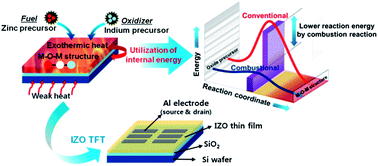Two-component solution processing of oxide semiconductors for thin-film transistors via self-combustion reaction†
Abstract
Indium zinc oxide (IZO) thin films were fabricated via self-combustion of In and Zn salts coordinated with fuel and oxidizer ligands. The intense heat generated from the exothermic reaction compensated for the energy required for oxide formation and reduced the temperature required to anneal the oxide films. Thermal analysis of the fuel and oxidizer precursors confirmed the generation of exothermic heat at a relatively low annealing temperature. With the aid of the internal energy that evolved as heat from the combustion reaction, the formation of the metal–oxygen–metal lattice and the removal of organic ligands could be easily accomplished with lower amounts of externally supplied energy. IZO thin-film transistors (TFTs), obtained from this combustive In–Zn pair at a low annealing temperature of 350 °C, showed a significantly enhanced field-effect mobility of 13.8 cm2 V−1 s−1 and a high on/off current ratio of 1.06 × 108. Inkjet printing of the combustive precursors yielded TFTs with a high field-effect mobility of 5.3 cm2 V−1 s−1 and an on/off ratio of 106. The high performance, good device uniformity, and high yield of TFTs fabricated by our self-combustion method demonstrate the potential of the proposed system to facilitate the processing of flexible printed electronics.


 Please wait while we load your content...
Please wait while we load your content...